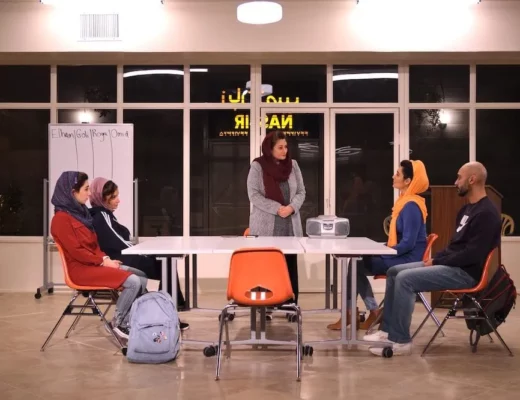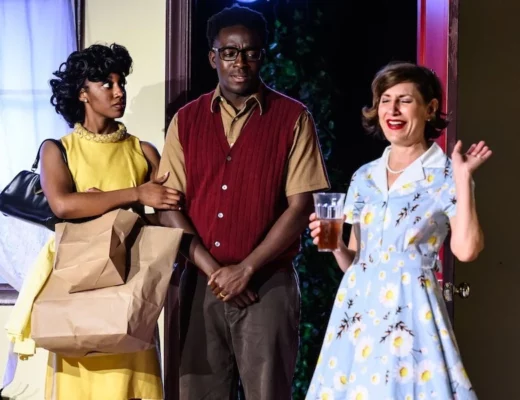A phone rings. The voice on the other end reports that there’s an emergency: a teddy bear has broken its leg and needs to see a doctor right away. Thankfully, the phone was answered by teaching artist Elizabeth Bruce and her young students are now on the case.
This scenario is one of many “journeys” created by Bruce through her Theatrical Journey project at CentroNía, an award-winning educational organization in Columbia Heights, where she serves as Community Arts Producer. Theatrical Journey use the arts to develop problem-solving skills in students aged three through five. The students solve scientific problems in pretend play scenarios: “journeys.”
As summer reaches its middle, American parents and students alike begin to think about returning to school for the fall. Simultaneously, the U.S. Department of Education is working to finalize statutes for implementation of the Every Student Succeeds Act, the 2015 national education legislation that will impact student teaching and curriculum across the country. Just as policymakers are considering a new approach to public education, unconventional educators like Elizabeth Bruce provide a window into a potential future.
“I have the best job!” Bruce exclaims in a Columbia Heights coffee shop.
While she has never lived in the neighborhood, Bruce has a special affinity for the area where she has taught young children for decades. “[My husband] Michael and I actually pre-date CentroNía on that block, because we were there doing theatre in ’83 or ’84,” she points out with a laugh.
Indeed, CentroNía, a multicultural learning community, was founded in Columbia Heights in 1986. Today, the nationally-recognized, award-winning organization provides a variety of services to low-income families in the area, including a robust early education program through which Bruce has developed Theatrical Journey.
“[The] Theatrical Journey program enriches our early learners’ classroom experience by providing an opportunity to become hands-on science experts and problem solvers through guided pretend play, which research shows is how children under the age of five learn best,” says Kate Akalonu, Director of Communications and Development with CentroNía.
Bruce’s own theatrical journey – from growing up in Texas to working with CentroNía – provided her professional experience as a theatre artist and creative problem-solver.
Growing up in the small Gulf Coast town of La Marque, Texas, Bruce didn’t develop an interest in theatre until she moved to Colorado to start college classes. “My interest in doing theatre started as an English major [at Colorado College], just reading Shakespeare plays aloud in class. I remember being assigned the role of [King] Lear’s Fool … It was great. I had such a great time.”
After college graduation she took acting classes in the Speech and Communications department at Metropolitan State College, which led to work as an actor for productions in the Denver and Boulder, Colorado areas. After a short stint in New York City – “I couldn’t handle the intensity of the energy” – and an even shorter time living back in Texas, Bruce eventually moved to Washington, D.C. Shortly thereafter she met her future husband, Michael, with whom she founded Sanctuary Theatre in 1984. The company performed in and took its name from the sanctuary of Calvary United Methodist Church.
After a few years of doing theatre work with Sanctuary, Bruce turned her focus to performing arts education. In 1987, Bruce, her husband, and a few other colleagues began teaching drama classes and workshops at the Calvary Multicultural Bilingual Learning Center, which would later become CentroNía. Bruce became a full-time employee of CentroNia in 2005 after nearly two decades as an associated teaching artist and consultant.

A student at CentroNia working in a Journey class. Photo courtesy CentroNia.
“Elizabeth is a true CentroNía gem,” Akalonu said. “With each day she brings so much joy and creative power to the CentroNía hallways … Whenever there is an opportunity to collaborate with Elizabeth, it is always a joy and she always brings a unique and creative perspective to the table.”
Inspired by a need for austerity following the 2008 recession, Bruce created the low-tech Theatrical Journey program in 2012 as a way to revitalize the arts in CentroNia’s early childhood education program. “We had a whole bunch of emergency preparedness workshops. I started suggesting that we have emergency preparedness pretend play sessions…. which everyone felt was a good idea,” Bruce recalls. “We never actually went that route, but it led me to doing pretend play again with children and [from there] I decided to focus on science content.”
Integrating the arts into core curriculum alongside subjects like science and math has been a central conversation among educators over the past decade. Teacher Georgette Yakman developed the acronym STEAM in 2006, adding an “A” for “Arts” to the popular education acronym STEM (Science, Technology, Engineering, and Mathematics.)
Lissa Rosenthal-Yoffe, executive director of the DC Arts and Education Collaborative, wrote, “It’s more than just adding the Arts to the acronym as much as amplifying the role of the Arts to the core relevancy of learning and a well-rounded education. The Arts are at the stem of all learning. Every student deserves to have equitable access to the arts, both in and outside the classroom, fully integrated into all facets of their learning.”
Bruce created Theatrical Journey as a STEAM curriculum. The curriculum asks students to do hands-on science “experiments” in 30-minute play scenarios. Each scenario begins with Bruce welcoming her “super scientists” or “super doctors” to their laboratory and asking them to put on the proper “costume” for the scenario; a lab coat, a doctor’s coat, protective eyewear. Then the classroom phone rings and the “science problem-solvers” get their assignment: the problem of the day. Problems range from the aforementioned sick teddy bear to understanding how the water cycle functions or how volcanic eruptions work.
The scientific processes central to the journeys are re-created in the classroom with creative substitutes that Bruce creates by hand; a salad bowl turned upside down and covered in shelf paper becomes a mountain, for instance. “One aspect of the Theatrical Journey project that has been great fun is creating these very low-tech, child-friendly simulations of actual scientific processes”, Bruce said.
Bruce was surprised to find that despite the make-believe, according to evaluations she’s solicited from them, her students consider the Journey program a science class. She admits a central goal of the project is to help children think of themselves as science problem-solvers from an early age.
“The students stay with these ‘science problem-solver’ roles and [it] becomes a part of them,” she says.
Theatrical Journey is similar in some ways to “Mantle of the Expert,” an educational approach developed by British educator Dorothy Heathcote in the 1970s. Bruce, like Heathcote, uses dramatic play to make children experts, acclimating them to real-world applications. Bruce is quick to remind that the program is focused on the most basic concepts, – “There’s very little ‘real’ science happening” – but that the learning process and cognitive habits the students develop are most important.
“The number one rule in [improvised performance] is ‘Yes, and,’ never ‘Yes, but’… The number one rule of a journey class is that there are no wrong answers,” she clarifies.
Theatrical Journey is about to enter its fifth year and Bruce is currently creating a curriculum playbook for the program through a three-year fellowship supported by the McCarthey Dressman Education Foundation. The program’s development at CentroNía has additionally been supported by a grant from the DC Commission on the Arts & Humanities.
Last year, CentroNía contracted with the Catholic University of America (CUA) to conduct an IRB-approved (Institutional Review Board) research evaluation of Theatrical Journey led by CUA Associate Professor Dr. Sandra Barrueco. Preliminary results from Dr. Barrueco’s evaluations suggest strong positive impact. Students who participated in the Journey program saw a statistically significant growth in scientific knowledge. Further, the study showed that CentroNía students have higher receptive language skills than their peers, which “is impressive since many studies with low-income, bilingual children find gaps starting in the early childhood years.”
Bruce is keenly aware of the particular needs of the community she serves in Columbia Heights; a majority of her students speak Spanish in their homes. While Theatrical Journey is taught primarily in English, Bruce and the CentroNía team are working on a Spanish-oriented version. She is careful, too, to include images of scientists and doctors in the curriculum who look like her students: “Not all doctors are white men!,” she reminds.
With the Every Students Succeeds Act the door has opened to state level education standards, responsive to needs at the local level, and STEAM integrated. Through the curriculum playbook she is developing, Bruce hopes to make Theatrical Journey more accessible to classroom teachers and other teaching artists, both locally and nationally.
“I would love to create more journeys,” she responds when asked about the future. She would also like to mentor other teachers on the Journey curriculum, she says, but is in no rush to leave the classroom. “It’s this really sweet life to work with children,” Bruce says with a smile.
The piece was originally posted on DC Theatre Scene and additionally published on UrbanScrawl.





1 Comment
Highlights - July 22 - Artapedia
July 25, 2016 at 4:03 pm[…] Elizabeth Bruce’s Theatrical Journey “Just as policymakers are considering a new approach to public education, unconventional educators like Elizabeth Bruce provide a window into a potential future.” […]